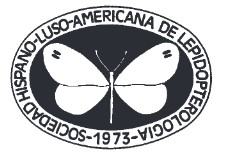Muerte embrionaria como probable razón para el colapso de la densidad de población en Lymantria dispar (Linnaeus, 1758) (Lepidoptera: Erebidae, Lymantriinae)
DOI:
https://doi.org/10.57065/shilap.939Palabras clave:
Lepidoptera, Erebidae, Lymantriinae, Lymantria dispar, dinámica de poblaciones, muerte embrionaria, nucleopolihedrovirusResumen
Se investiga por primera vez con métodos bioquímicos y moleculares, las causas de la muerte masiva de embriones en una población de Lymantria dispar (Linnaeus1758). En este estudio se recogieron y analizaron masas de huevos de dos poblaciones en el territorio de Rusia: con baja (la población siberiana occidental) y alta densidad (Trans-Ural), respectivamente. La eclosión en primavera de las larvas de los huevos, guardados bajo condiciones contantes del laboratorio a 2º C, fue dos veces menor (la mitad) en las poblaciones de insectos de la Trans-Ural (TU) que en la del oeste siberiano (WS) (43 ± 6 % y 86 ± 7 % respectivamente). El nivel de virus definido por PCR para las poblaciones de TU y WS era de 76 ± 9 % y 36 ± 6 %, respectivamente. La mayoría de los componentes importantes de los huevos eran prácticamente los mismos entre las poblaciones. Sin embargo, encontramos una presencia reducida de proteínas importantes para la embriogénesis en la población de TU, como por ejemplo,una molécula parecida al pro-arilforin y una falta del componente pro-vitelín 2. Los datos de campo fueron comparables a éstos del laboratorio, y en las poblaciones de TU, había un decrecimiento de la densidad. Los resultados obtenidos indican que la alteración en el balance hormonal de los insectos infectados con nucleopolihedrovirus (NPV) podría llevar a un disminucion o falta de algunas proteínas de la embriogénesis en huevos. Puede influir en el desarrollo de las larvas desde los huevos y, en consecuencia, en la dinámica de población del lepidóptero.
Descargas
Estadísticas globales ℹ️
|
224
Visualizaciones
|
130
Descargas
|
|
354
Total
|
|
Citas
BRADFORD, M., 1976.– A rapid and sensitive method for the quantitation of microgram quantities of protein utilizing the principle of protein-dye binding.– Analytical Biochemistry, 72: 248-254. DOI: https://doi.org/10.1006/abio.1976.9999
BURDEN, J. P., GRIFFITS, C. M., CORY, J. S., SMITH, P. & SAIT, S. M., 2002.– Vertical transmission of sublethal granulovirus infection in the Indian meal moth, Plodia interpunctella.– Molecular Ecology, 11: 547-555. DOI: https://doi.org/10.1046/j.0962-1083.2001.01439.x
CABODEVILLA, O., VILLAR, E., VITRO, C., MURILLO, R., WILLIAMS, T. & CABALLERO, P., 2011.– Intraand intergenerational persistence of an insect nucleopolyhedrovirus: adverse effects of sublethal disease on host development, reproduction, and susceptibility to superinfection.– Applied and Environmental Microbiology, 77: 2954-2960. DOI: https://doi.org/10.1128/AEM.02762-10
CHABROL, E. & CHARONNAT, R., 1937.– Une nouvelle reaction pour l’étude des lipids. L’eleidemie.– La presse médicale, 45: 1713-1714.
CORY, J. S. & MYERS, J. H., 2003.– The ecology and evolution of insect baculoviruses.– Annual Review of Ecology Evolution and Systematics, 34: 239-272. DOI: https://doi.org/10.1146/annurev.ecolsys.34.011802.132402
DWYER, G. & ELKINTON, J. S., 1995.– Host dispersal and the spatial spread of insect pathogens.– Ecology, 76: 1262-1275. DOI: https://doi.org/10.2307/1940933
EGOROV, N. N., 1958.– Pest insects of pine forests of West Siberia.– Zoologicheskiy zhurnal, 37: 1488-1499 [in Russian with English summary].
ELKINTON, J. S., 1990.– Population dynamics of gypsy moth in North America.– Annual Review of Entomology, 35: 517-596 DOI: https://doi.org/10.1146/annurev.ento.35.1.571
FULLER, E., ELDERD, B. D. & DWYER, G., 2012.– Pathogen Persistence in the Environment and Insect- Baculovirus Interactions: Disease-Density Thresholds, Epidemic Burnout and Insect Outbreaks.– American Naturalist, 179: 70-96. DOI: https://doi.org/10.1086/664488
GIESE, R. L. & SCHNEIDER, M. L., 1979.– Cartographic comparisons of Eurasian gypsy moth distribution (Lymantria dispar L., Lepidoptera: Lymantriidae).– Entomological News, 90: 1-16.
HAMILTON, A. G., 1950.– Further studies on the relation of humidity and temperature to the development of two species of African locusts - Locusta migratoria migratorioidaes (R. & F.) and Schistocerca gregaria (Forsk.).– Transactions of the Royal Entomological Society of London, 101: 1-58. DOI: https://doi.org/10.1111/j.1365-2311.1950.tb00374.x
HANSEN, J. & MøLLER, I., 1975.– Percolation of starch and soluble carbohydrates from plant tissue for quantitative determination with anthrone.– Analytical Biochemistry, 68: 87-94. DOI: https://doi.org/10.1016/0003-2697(75)90682-X
HOCH, G., ZUBRIC, M., NOVOTNY, J. & SCHOPF, A., 2001.– The natural enemy complex of the gypsy moth, Lymantria dispar (Lepidoptera, Lymantriidae) in different phases of its population dynamics in eastern Austria and Slovakia, a comparative study.– Journal of Applied Entomology, 125: 217-227. DOI: https://doi.org/10.1046/j.1439-0418.2001.00540.x
ILYINSKY, A. I. & TROPIN, I. V. (eds.), 1965.– Supervision, registration and prognosis of outbreaks of needle-and leaf-eating insects in forests of the USSR. Moscow: Lesnaya Promishlennost’ [in Russian].
ILYINYKH, A. V., 2002.– Analysis of causes of waning of mass reproduction of gypsy moth (Lymantria dispar L.) in the territory of the Novosibirsk region.– Contemporary problems of ecology, 6: 697-702.
ILYINYKH, A. V., 1997.– The method for the laboratory cultivation of Ocneria dispar L.– Biotechnologiya, 9-10: 27-29. [in Russian with English summary].
ILYINYKH, A. V. & POLENOGOVA, O. V., 2013.– Demonstration of remote effect for vertical transmission of baculovirus based on example of gypsy moth, Lymantria dispar L. (Lepidoptera, Lymantriidae).– Biology Bulletin Reviews, 3: 214-218. DOI: https://doi.org/10.1134/S2079086413030055
ILYINYKH, A. V., SHTERNSHIS, M. V. & KUZMINOV, S. V., 2004.– Exploration into a mechanism of transgenerational transmission of nucleopolyhedrovirus in Lymantria dispar L. in Western Siberia.– BioControl, 49: 441-454. DOI: https://doi.org/10.1023/B:BICO.0000034592.30160.50
INCEOGLU, A. B., KAMITA, S. G. & HAMMOCK, B. D., 2006.– Genetically modified baculoviruses: a historical overview and future outlook.– Advances in Virus Research, 68: 323-360. DOI: https://doi.org/10.1016/S0065-3527(06)68009-3
IZUMI, S., YANO, K., YAMAMOTO, Y. & TAKAHSHI, S. Y., 1994.– Yolk proteins from insect eggs: Structure, biosynthesis and programmed degradation during embryogenesis.– Journal of Insect Physiology, 40: 735-746. DOI: https://doi.org/10.1016/0022-1910(94)90001-9
JOHNSON, D. M., LIEBHOLD, A. M., BJØRNSTAD, O. N. & MCMANUS, M. L., 2005.– Circumpolar variation in periodicity and synchrony among gypsy moth populations.– Journal of Animal Ecology, 74: 882-892. DOI: https://doi.org/10.1111/j.1365-2656.2005.00980.x
KOLTUNOV, E. V., PONOMAREV, V. I. & FEDORENKO, S. I., 1998.– The gypsy moth Lymantria dispar ecology in conditions of anthropogenic influences. Ekaterinburg: UB RAS [in Russian with English summary].
KONDAKOV, Yu. P., 1963.– The gypsy moth (Ocneria dispar L.) in Krasnoyarsk region forests.– In Protection of Siberian forests from pest insects: 30-77. Lesnaya Promishlennost’, Moscow. [in Russian].
KOUASSI, L. N’G., TSUDO, K, GOTO, C., MUKARAVA, S., SAKAMAKI, S., KUSIGEMATI, K. & NAKAMURA, M., 2009.– Prevalence of latent virus in Spodoptera litura (Fabricius) (Lepidoptera: Noctuidae) and its activation by geterologous virus.– Applied Entomology and Zoology, 44: 95-102. DOI: https://doi.org/10.1303/aez.2009.95
KUKAN, B., 1999.– Vertical transmission of nucleopolyhedrovirus in insects.– Journal of Invertebrate Pathology, 74: 103-111. DOI: https://doi.org/10.1006/jipa.1999.4873
MURILLO, R., HUSSEY, M. S. & POSSEE, R. D., 2011.– Evidence for covert baculovirus infections in a Spodoptera exigua laboratory culture.– Journal of General Virology, 92: 1061-1070. DOI: https://doi.org/10.1099/vir.0.028027-0
MYERS, J., MALAKAR, H. R. & CORY, J. S., 2000.– Sublethal nucleopolyhedrovirus infection effects on female pupal weight, egg mass size, and vertical transmission in gypsy moth (Lepidoptera: Lymantriidae).– Environmental Entomology, 29: 1268-1272. DOI: https://doi.org/10.1603/0046-225X-29.6.1268
O’REILY, D. R. & MILLER, L. K., 1989. - A baculovirus blocks insect molting by producing ecydysteroid UDPglucosyl transferase.– Science, 245: 1110-1112. DOI: https://doi.org/10.1126/science.2505387
QUICKENDEN, K. L., 1970.– Carbohydrates in eggs of the grasshopper, Aulocara elliotti, during development.– Journal of Insect Physiology, 16: 171-183. DOI: https://doi.org/10.1016/0022-1910(70)90124-1
ROHRMANN, G. R., 2008.– Baculovirus molecular biology. Available from http://www.ncbi.nlm.nih.gov/books/NBK1736/.
SANDER, K., GUTZEIT, H. O. & JACKIE, H., 1985.– Insect Embryogenesis: Morphology, Physiology, Genetical and Molecular Aspects.– Comprehensive insect physiology, biochemistry and pharmacology, 1: 319-385.
SLAVICEK, J. M., POPHAM, H. J. R. & RIEGEL, C. I., 1999.– Deletion of the Lymantria dispar multicapsid nucleopolyhedrovirus ecdysteroid UDP-glucosyltransferase gene enhances viral killing speed in the last instar of the gypsy moth.– Biological Control, 16: 91-103. DOI: https://doi.org/10.1006/bcon.1999.0734
VILAPLANA, L., REDMAN, E. M., WILSON, K. & CORY, J. S., 2008.– Density- related variation in vertical transmission of a virus in the African armyworm.– Oecologia, 155: 237-246. DOI: https://doi.org/10.1007/s00442-007-0914-9
ZHOU, M., SUN, X., SUN, X., VLAK, J. M., HU, Z. & VAN DER WERF, W., 2005.– Horizontal and vertical transmission of wild-type and recombinant Helicoverpa armigera single-nucleocapsid nucleopolyhedrovirus.– Journal of Invertebrate Pathology, 89: 165-175. DOI: https://doi.org/10.1016/j.jip.2005.03.005
Publicado
Cómo citar
Número
Sección
Licencia

Esta obra está bajo una licencia internacional Creative Commons Atribución 4.0.
El autor retiene sus derechos de marca y patente sobre cualquier proceso o procedimiento dentro del artículo.
El autor retiene el derecho de compartir, distribuir, ejecutar y comunicar públicamente el artículo publicado en SHILAP Revista de lepidopterología, con reconocimiento inicial de su publicación en SHILAP Revista de lepidopterología.
El autor retiene el derecho para hacer una posterior publicación de su trabajo, de utilizar el artículo a publicarlo en un libro, siempre que indique su publicación inicial en SHILAP Revista de lepidopterología.
Cada envío a SHILAP Revista de lepidopterología debe ir acompañado de una aceptación de los derechos de autor y del reconocimiento de autoría. Al aceptarlos, los autores conservan los derechos de autor de su trabajo y aceptan que el artículo, si es aceptado para su publicación por SHILAP Revista de lepidopterología, tendrá una licencia de uso y distribución “Reconocimiento 4.0 Internacional de Creative Commons” (CC BY 4.0), que permite a terceros compartir y adaptar el contenido para cualquier propósito dando el crédito apropiado al trabajo original.
Puede consultar desde aquí la versión informativa y el texto legal de la licencia. La indicación de la licencia CC BY 4.0 debe indicarse expresamente de esta manera cuando sea necesario.
A partir de 2022, el contenido de la versión impresa y digital se encuentra bajo una licencia de uso y distribución “Reconocimiento 4.0 Internacional de Creative Commons” (CC BY 4.0), que permite a terceros compartir y adaptar el contenido para cualquier propósito dando el crédito apropiado al trabajo original.
El contenido anterior de la revista se publicó bajo una licencia tradicional de derechos de autor; sin embargo, el archivo está disponible para acceso gratuito.
Al usar el contenido de SHILAP Revista de lepidopterología publicado antes del año 2022, incluidas figuras, tablas o cualquier otro material en formato impreso o electrónico pertenecen a los autores de los artículos, los autores deben obtener el permiso del titular de los derechos de autor. Las responsabilidades legales, financieras y penales a este respecto pertenecen al autor(es).
En aplicación del Principio de Prioridad del Código Internacional de Nomenclatura Zoologica, no se autoriza el depósito en repositorios, páginas web personales o similares de cualquier otra versión distinta a la publicada por el editor.




























